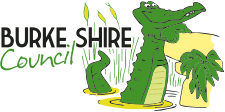
Back Burke (rehiyon) CEB Burke Shire German Comté de Burke (Queensland) French Contea di Burke (Australia) Italian Берк (графство) Russian Burke Shire Swedish 伯爾克郡政府 Chinese
| Shire of Burke Queensland | |||||||||||||||
|---|---|---|---|---|---|---|---|---|---|---|---|---|---|---|---|
 Location within Queensland | |||||||||||||||
| Population | 419 (2021 census)[1] | ||||||||||||||
| • Density | 0.010558/km2 (0.02735/sq mi) | ||||||||||||||
| Established | 1885 | ||||||||||||||
| Area | 39,684 km2 (15,322.1 sq mi)[2] + | ||||||||||||||
| Mayor | Ernie Camp | ||||||||||||||
| Council seat | Burketown | ||||||||||||||
| Region | North West Queensland | ||||||||||||||
| State electorate(s) | Traeger | ||||||||||||||
| Federal division(s) | Kennedy | ||||||||||||||
 | |||||||||||||||
| Website | Shire of Burke | ||||||||||||||
| |||||||||||||||
The Shire of Burke is a local government area in North West Queensland, Australia. The shire lies on the south coast of the Gulf of Carpentaria and abuts the border with the Northern Territory. It covers an area of 39,864 square kilometres (15,391.6 sq mi), and has existed as a local government entity since 1885. The major town and administrative centre of the shire is Burketown.
The shire and town are named in honour of ill-fated explorer Robert O'Hara Burke.[3] The Gangalidda name for Burketown is Mungibi meaning ‘little Island’ for the fact that flooding in the wet season often isolates the town.[citation needed]
From the months of August to November, a rare meteorological phenomenon known as "Morning Glory" – long, tubular clouds, some up to 1000 km in length – are often observed in the skies above Burke Shire.[4]
The shire contains Boodjamulla National Park (formerly called Lawn Hill National Park) and the World Heritage Site Riversleigh fossil fields. The Aboriginal Shire of Doomadgee lies inside Burke Shire to the west of Burketown. It also includes Gregory Downs.
In the 2021 census, the Shire of Burke had a population of 419 people.[1]
- ^ a b Cite error: The named reference
Census2021was invoked but never defined (see the help page). - ^ "3218.0 – Regional Population Growth, Australia, 2017-18: Population Estimates by Local Government Area (ASGS 2018), 2017 to 2018". Australian Bureau of Statistics. Australian Bureau of Statistics. 27 March 2019. Retrieved 25 October 2019. Estimated resident population, 30 June 2018.
- ^ "Burketown (entry 5355)". Queensland Place Names. Queensland Government. Retrieved 13 September 2015.
- ^ ABC Australia, August 2003, Soaring the Glory Accessed 12 December 2006.